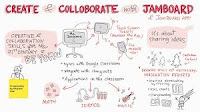Jamboard provides you with a whiteboard space where you can draw, add sticky notes, import images, or add Google Docs, Sheets, and Slides. Jamboards live in your Google Drive and are shared similarly to other Google Suite apps.
Some ideas on how you could use Jamboard in your classroom with students:
- Space for group project resources
- Collaborative brainstorming
- Design thinking or challenges
- Collaborative graphic organizers
- Presentations - Jams can have multiple pages!
- Mind mapping
- Character analysis in novels
The uses are only limited by your imagination!
The example below shows students' thoughts and findings on identifying bias and credible sources:
How is Jamboard different from other Google products?
- You are given a 'whiteboard space' to place items where desired.
- The background options include lines, graph paper, and a few colors.
- The drawing tool allows students to write or draw. (Students don't seem to mind using the trackpad to draw!)
- Ability to add images.
- Ability to add Google Docs, Sheets, or Slides into the workspace.
The example below is very simple, but it gives you an idea of how Jamboard works. You and your students can easily take this to the next level!
That's my tip for today!
(Google has made Jamboard a little confusing in that there are actual boards called Jamboards (hardware), and then there is the software. You don't need the expensive hardware to use the software!)
(Google has made Jamboard a little confusing in that there are actual boards called Jamboards (hardware), and then there is the software. You don't need the expensive hardware to use the software!)
Resources
Video: How to use the Jamboard app (slightly dated and may talk about a few features only available using the hardware)




Comments
Post a Comment